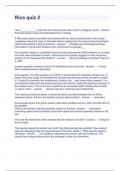Other
[NEW DOCUMENT] THE TEFL ACADEMY - ASSIGNMENT B [FIRST CONDITIONAL]
- Course
- Institution
This document presents Assignment B from the TEFL Academy focusing on the first conditional within the context of the environment. It's a comprehensive, well-researched, and professionally crafted document that encompasses all six required sections. Using this resource will help you to create an ou...
[Show more]




